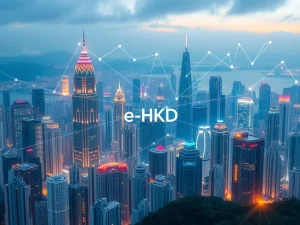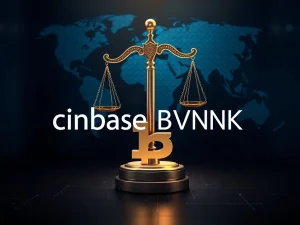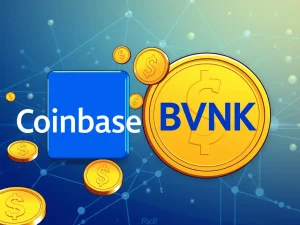Unveiling Truth: Regulation Isn’t Stalling Tokenization Revolution, Says Prometheum CEO

In the rapidly evolving world of cryptocurrency and blockchain, tokenization of real-world assets (RWAs) is gaining significant traction. However, contrary to popular assumptions, the primary obstacle hindering its widespread adoption isn’t stringent regulation, but rather the scarcity of robust secondary markets. This is the compelling insight shared by Prometheum’s co-CEO, Aaron Kaplan, in a recent interview, challenging the common narrative and sparking a crucial conversation about the future of digital assets.
Is Regulation Really the Bottleneck for Tokenization?
For a long time, the conversation around tokenization has been dominated by concerns about regulatory uncertainty. Many believed that unclear rules and guidelines were the main factors slowing down the progress of tokenizing real-world assets. Even prominent figures like ARK Invest CEO Cathie Wood have voiced concerns about the lack of regulatory clarity preventing them from fully embracing tokenization.
However, Aaron Kaplan of Prometheum offers a different perspective. He argues that the regulatory framework in the US, particularly the SEC’s special purpose broker-dealer framework and ATS licensing, already provides a viable and regulated pathway for issuing blockchain-native funds. According to Kaplan, these frameworks offer efficiency advantages over traditional methods. So, if regulation isn’t the primary issue, what is?
The Real Hurdle: Lack of Secondary Markets for RWA Tokenization
Kaplan pinpoints the real bottleneck as the “limited market infrastructure” for trading tokenized securities. He emphasizes that while the market for tokenized RWAs is experiencing daily growth, a critical piece is missing: accessible and liquid secondary markets.
Consider these key points:
- Growing RWA Market: Excluding stablecoins, the tokenized RWA market has grown by nearly 8% in the last month alone, reaching a substantial $19.5 billion.
- Dominant Use Cases: Private credit and US Treasury debt are currently leading the way as the largest use cases for tokenized RWAs.
- Missing Infrastructure: Despite this growth, there’s a significant absence of fully public secondary markets where both institutional and retail investors can seamlessly buy, sell, and trade these tokenized assets, unlike traditional securities on established exchanges or brokerage platforms.
This lack of accessible secondary markets is preventing broader adoption and hindering the full potential of tokenization.
Two Paths to Building Secondary Markets for Digital Assets
Kaplan outlines two primary approaches to developing these crucial secondary markets for tokenized securities:
- DeFi-Based Markets: Leveraging decentralized finance (DeFi) frameworks to build tokenized securities markets. Companies like Ondo Finance, Ethena Labs, and Securitize are pioneering this approach, creating blockchain-based solutions for trading tokenized assets.
- Brokerage Platform Integration: Integrating tokenization protocols into existing brokerage platforms that are already regulated by the SEC and operate under federal securities laws. This approach would involve traditional financial institutions adopting tokenization technology to expand their service offerings.
The race is on to see which approach will dominate. Will it be the agile and innovative DeFi platforms, or will traditional brokerages adapt and integrate tokenization to maintain their market position?
Will Crypto Platforms or Brokerages Dominate the Future of RWA Secondary Markets?
The question of who will build the next generation of markets for digital securities is central to the future of digital asset adoption. Kaplan suggests that legacy crypto and fintech platforms, already familiar with cryptocurrency trading, are likely candidates to expand into tokenized securities. However, traditional brokerages, while potentially slower to adapt, are unlikely to concede market share without a fight.
Here’s what’s at stake:
- Competition is Heating Up: Many traditional financial players are actively investing in their own tokenization initiatives or forming partnerships with fintech and crypto firms to stay competitive in this evolving landscape.
- Onboarding the Next Wave of Users: The development of user-friendly secondary markets is crucial for attracting a wider range of users into the digital asset space.
- Bridging the Infrastructure Gap: Companies like Prometheum are actively working to bridge this infrastructure gap by building comprehensive digital asset securities marketplaces, aiming to provide reduced fees, faster settlement times, and increased efficiency.
The Investor Demand for ‘Digital Native’ Assets
A significant driver for tokenized assets is investor demand. Traditional investors are increasingly seeking “digital native versions of all assets.” They desire a unified ecosystem where they can access both traditional assets and crypto tokens to achieve diverse financial goals. This demand is pushing the financial industry to innovate and provide these integrated solutions.
Real estate tokenization is one area showing significant promise. Luxury and commercial properties are being tokenized across North America, and secondary markets are emerging to facilitate the trading of tokenized real estate shares. This demonstrates the tangible applications and growing acceptance of tokenization in various sectors.
Tokenization: A Game-Changer with Untapped Potential
Industry reports and thought leaders are increasingly recognizing the transformative potential of tokenization:
- Boston Consulting Group (BCG) Report: A 2024 BCG report hails tokenization as a “game-changing blockchain use case in financial services,” citing its scalability and near-instant transaction capabilities. BCG estimates that tokenization could boost investors’ annual returns by approximately $100 billion and significantly increase revenue streams for financial institutions.
- World Economic Forum: The World Economic Forum also highlights tokenization’s potential, noting that a substantial portion of the global securities market ($230 trillion) is eligible for use as collateral. Tokenization can improve collateral mobility and capital efficiency, unlocking untapped capital and optimizing intraday liquidity.
Tokenized RWAs reached an “inflection point” in 2023, signaling a shift from nascent technology to a maturing and investable asset class. The future of finance is increasingly intertwined with tokenization, offering enhanced efficiency, accessibility, and potential for growth.
Conclusion: Embracing the Tokenization Revolution
While regulatory clarity remains important, the real challenge and opportunity in the tokenization space lie in building robust and accessible secondary markets. As Prometheum CEO Aaron Kaplan points out, the infrastructure for trading tokenized securities is the key to unlocking the full potential of RWAs. Whether it’s through innovative DeFi platforms or the evolution of traditional brokerages, the development of these markets will determine the pace and scale of the tokenization revolution. The demand is there, the technology is maturing, and the race to build the future of finance is well underway.







